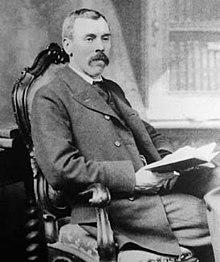Professor Henry Baker | |
|---|---|
 Henry Frederick Baker (1866-1956) | |
| Born | Henry Frederick Baker 3 July 1866 |
| Died | 17 March 1956 (aged 89) |
| Nationality | British |
| Alma mater | St John's College, Cambridge |
| Awards |
|
| Scientific career | |
| Fields |
|
| Institutions | University of Cambridge |
| Doctoral advisor | Arthur Cayley[1] |
| Doctoral students |
|
Henry Frederick Baker FRS[2] FRSE (3 July 1866 – 17 March 1956) was a British mathematician, working mainly in algebraic geometry, but also remembered for contributions to partial differential equations (related to what would become known as solitons), and Lie groups.[3]
Early life
He was born in Cambridge the son of Henry Baker, a butler, and Sarah Ann Britham.[4]
Education
He was educated at The Perse School before winning a scholarship to St John's College, Cambridge in October 1884. Baker graduated as Senior Wrangler in 1887, bracketed with 3 others.[5]
Career
Baker was elected Fellow of St John's in 1888 where he remained for 68 years.
In June, 1898 he was elected a Fellow of the Royal Society.[2][6] In 1911, he gave the presidential address to the London Mathematical Society.
In January 1914 he was appointed Lowndean Professor of Astronomy.
Gordon Welchman recalled that in the 1930s before the war Dennis Babbage and he were members of a group of geometers known as Professor Baker's "Tea Party", who met once a week to discuss the areas of research in which we were all interested.[7]
He married twice. Firstly in 1893 to Lilly Isabella Hamfield Klopp, who died in 1903, then he remarried in 1913, to Muriel Irene Woodyard.
He died in Cambridge and is buried at the Parish of the Ascension Burial Ground, with his second wife Muriel (1885 - 1956).
See also
- Baker–Campbell–Hausdorff formula
Publications
- Baker, Henry Frederick (1922), Principles of geometry. Volume 1. Foundations, Cambridge Library Collection, Cambridge University Press, doi:10.1017/CBO9780511718267.007, ISBN 978-1-108-01777-0, MR 2849917[8]
- Baker, Henry Frederick (1922), Principles of geometry. Volume 2. Plane geometry, Conics, circles, non-Euclidean geometry, Cambridge Library Collection, Cambridge University Press, doi:10.1017/CBO9780511718298.009, ISBN 978-1-108-01778-7, MR 2857757[8][9]
- Baker, Henry Frederick (1923), Principles of geometry. Volume 3. Solid geometry. Quadrics, cubic curves in space, cubic surfaces., Cambridge Library Collection, Cambridge University Press, ISBN 978-1-108-01779-4, MR 2857520[8][10]
- Baker, Henry Frederick (1925), Principles of geometry. Volume 4. Higher geometry. Being illustrations of the utility of the consideration of higher space, especially of four and five dimensions, Cambridge Library Collection, Cambridge University Press, ISBN 978-1-108-01780-0, MR 2849669[8]
- Baker, Henry Frederick (1933), Principles of geometry. Volume 5. Analytical principles of the theory of curves, Cambridge Library Collection, Cambridge University Press, ISBN 978-1-108-01781-7, MR 2850139[8]
- Baker, Henry Frederick (1933), Principles of geometry. Volume 6. Introduction to the theory of algebraic surfaces and higher loci., Cambridge Library Collection, Cambridge University Press, ISBN 978-1-108-01782-4, MR 2850141[8]
- Abel's theorem and the allied theory, including the theory of the theta functions (Cambridge: The University Press, 1897)
- An introduction to the theory of multiply periodic functions (Cambridge: The University Press, 1907)
- 1943 An Introduction to Plane Geometry
References
- ^ a b H. F. Baker at the Mathematics Genealogy Project
- ^ a b Hodge, W. V. D. (1956). "Henry Frederick Baker 1866-1956". Biographical Memoirs of Fellows of the Royal Society. 2: 49–68. doi:10.1098/rsbm.1956.0004. JSTOR 769475.
- ^ O'Connor, John J.; Robertson, Edmund F., "H. F. Baker", MacTutor History of Mathematics archive, University of St Andrews.
- ^ http://www.royalsoced.org.uk/cms/files/fellows/biographical_index/fells_indexp1.pdf
- ^ "Baker, Henry Frederick (BKR883HF)". A Cambridge Alumni Database. University of Cambridge.
- ^ "Library and Archive Catalogue". Royal Society. Retrieved 7 December 2010.
- ^ The Hut Six Story: Breaking the Enigma Codes by Gordon Welchman (1982, Allen Lane, London) pp 35, 85, 126 ISBN 0 7139 1294 4
- ^ a b c d e f Hollcroft, T. R. (1935). "Review of Principles of geometry, volumes 1–6, by H. F. Baker" (PDF). Bull. Amer. Math. Soc. 41 (11): 768–772. doi:10.1090/s0002-9904-1935-06177-4.
- ^ Woods, F. S. (1925). "Review of Principles of geometry, Vol. 2: Plane geometry. Conics, circles, non-Euclidean geometry by H. F. Baker" (PDF). Bull. Amer. Math. Soc. 31 (7): 370–371. doi:10.1090/S0002-9904-1925-04065-3.
- ^ Brown, B. H. (1926). "Review of Principles of geometry, Vol. 3: Solid geometry. Quadrics, cubic curves in space, cubic surfaces by H. F. Baker" (PDF). Bull. Amer. Math. Soc. 32 (2): 173–174. doi:10.1090/S0002-9904-1926-04189-6.